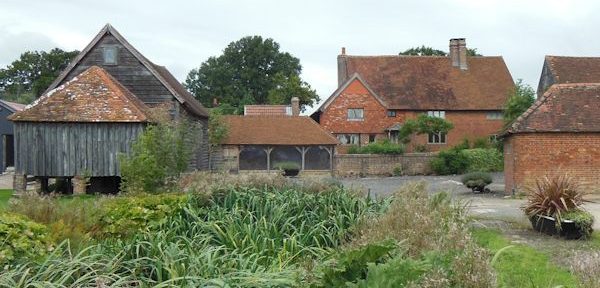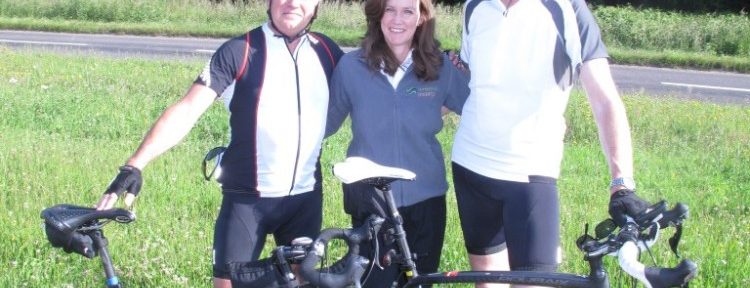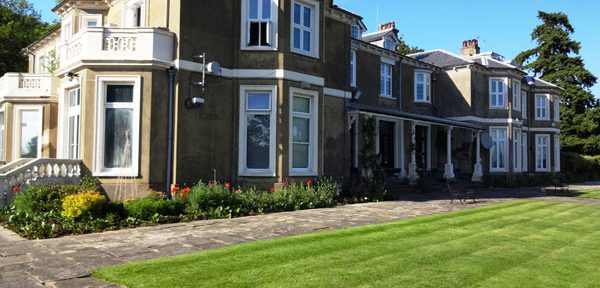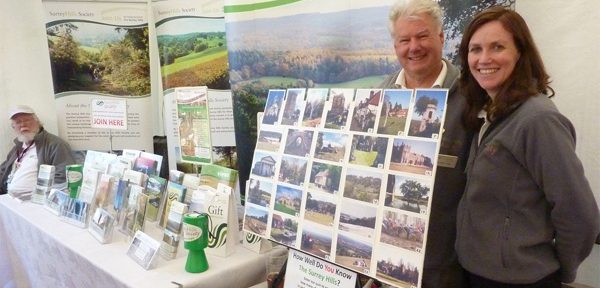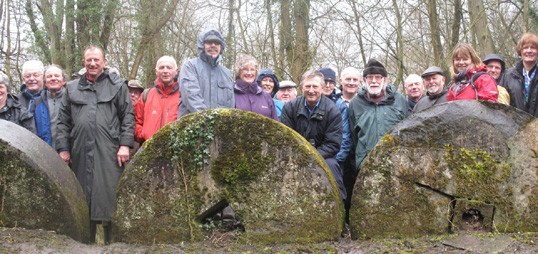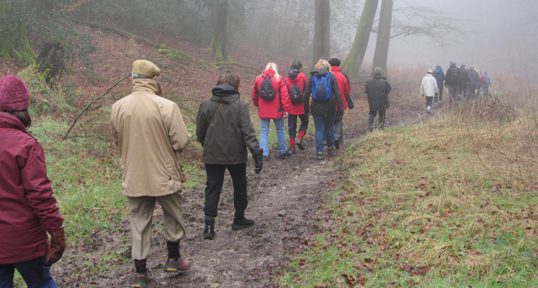 On a mid-September day, village historian John Callcut led more than 20 members of the Surrey Hills Society on a walk around the ancient fields and trackways of Newdigate. Newdigate means “the gate to Ewood”, where a gate implies a road, and the road in question led to the deer hunting lodge at Ewood. But first we sat in the spiritual heart of the village, the parish church of St Peter’s, to hear about the Newdigate family, and to inspect the magnificient wood carvings on the pews and the four angels below the high altar. We stopped off at the village pond to see where the horse drawn carts were driven in, to soak the wooden wheels thus preventing them shrinking and the iron tyres falling off. Then it was over our first stile, towards the medieval patchwork of fields, John Callcut had kindly mapped out on a handout. Our first field is Swampet field, a very wet field, followed by Fox Causeway, which had a ridge of high ground, allowing the foxes to run across this field in the dry. Then onto Church field, and a glimpse of St Peter’s steeple in the distance. We arrived at the ancient dirt track called Green Lane, bordered by a stream full of common soft rush (Juncus Effusus ). This ancient track runs north-south, a major transportation route until the Victorians built their roads in the 1870s. On the cusp of autumn, the trees around us were still green. The hedges full of crab apple fruits, dog rosehips, red hawthorn berries, and clutches of elderberries and sloes. We passed the old marl pits of Kiln field and Field Platt, where they made fertilizer by firing up chalk from Betchworth Quarry, to create lime and spread over the fields. The next field Stoney Furrow, named because of it’s soil type, followed by Beechen Field surrounded by beech trees. In front of Home Farm (originally named Newdigate Place), we heard how the Newdigate Family came to re-locate to Nuneaton in Warwickshire, where they run a successful conference centre in another of their ancestral homes (said to feature in George Eliot’s novels). . Tanhurst Farm was our next visit, once used for leather tanning, but now renowned for its catering. The tea shop is popular with cyclists and the playground outside attracts families. The newly built extension shows what a popular stop it has become. The farm shop sells its own frozen dinners www.tanhousefarmshop.co.uk . They even supply an evening dinner party service in your own home to take the strain out of all that defrosting. Waitresses from Tanhurst Farm serve the first course whilst the main course, and pudding are self service. Tanhurst Farm staff then return to collect the dirty washing up?? what a really original and fantastic idea! In this way, Tudor farms can remain viable as micro-businesses into the 21st Century A few fields away, Greens Farm has won an outstanding reputation for wedding receptions, which has increased the congregation at St Peter’s. As couples booking the wedding venue also opt to get married in the local church, and attend services ahead of their wedding day. The many restored outbuildings alongside Greens Farm are also put to good use. I liked the scented lavender path leading to the barn door of the village osteopath. The surrounding lakes, are stocked as fisheries. As we walked by, a tractor mows the grass to keep the path wide enough for those pack-loads of equipment that the modern fisherman finds essential. Turning for our last look at the beautiful farm house, John points out the garderobe, a small overhang on the first floor, used in Medieval times as a toilet. We ended our walk at some new affordable eco-housing, clad in spruce panels, with solar panels on the roof. Built on poor farmland for people with a strong connection with the village, it has yet to establish a proper visual connection to the native timber and brick cottages surrounding it. Given its chequered history of boom and bust, it’s heartening to see that the renewed investment of incoming Victorians continues to this day as Newdigate continually reinvents itself as a thriving village that has held on to its identity.
On a mid-September day, village historian John Callcut led more than 20 members of the Surrey Hills Society on a walk around the ancient fields and trackways of Newdigate. Newdigate means “the gate to Ewood”, where a gate implies a road, and the road in question led to the deer hunting lodge at Ewood. But first we sat in the spiritual heart of the village, the parish church of St Peter’s, to hear about the Newdigate family, and to inspect the magnificient wood carvings on the pews and the four angels below the high altar. We stopped off at the village pond to see where the horse drawn carts were driven in, to soak the wooden wheels thus preventing them shrinking and the iron tyres falling off. Then it was over our first stile, towards the medieval patchwork of fields, John Callcut had kindly mapped out on a handout. Our first field is Swampet field, a very wet field, followed by Fox Causeway, which had a ridge of high ground, allowing the foxes to run across this field in the dry. Then onto Church field, and a glimpse of St Peter’s steeple in the distance. We arrived at the ancient dirt track called Green Lane, bordered by a stream full of common soft rush (Juncus Effusus ). This ancient track runs north-south, a major transportation route until the Victorians built their roads in the 1870s. On the cusp of autumn, the trees around us were still green. The hedges full of crab apple fruits, dog rosehips, red hawthorn berries, and clutches of elderberries and sloes. We passed the old marl pits of Kiln field and Field Platt, where they made fertilizer by firing up chalk from Betchworth Quarry, to create lime and spread over the fields. The next field Stoney Furrow, named because of it’s soil type, followed by Beechen Field surrounded by beech trees. In front of Home Farm (originally named Newdigate Place), we heard how the Newdigate Family came to re-locate to Nuneaton in Warwickshire, where they run a successful conference centre in another of their ancestral homes (said to feature in George Eliot’s novels). . Tanhurst Farm was our next visit, once used for leather tanning, but now renowned for its catering. The tea shop is popular with cyclists and the playground outside attracts families. The newly built extension shows what a popular stop it has become. The farm shop sells its own frozen dinners www.tanhousefarmshop.co.uk . They even supply an evening dinner party service in your own home to take the strain out of all that defrosting. Waitresses from Tanhurst Farm serve the first course whilst the main course, and pudding are self service. Tanhurst Farm staff then return to collect the dirty washing up?? what a really original and fantastic idea! In this way, Tudor farms can remain viable as micro-businesses into the 21st Century A few fields away, Greens Farm has won an outstanding reputation for wedding receptions, which has increased the congregation at St Peter’s. As couples booking the wedding venue also opt to get married in the local church, and attend services ahead of their wedding day. The many restored outbuildings alongside Greens Farm are also put to good use. I liked the scented lavender path leading to the barn door of the village osteopath. The surrounding lakes, are stocked as fisheries. As we walked by, a tractor mows the grass to keep the path wide enough for those pack-loads of equipment that the modern fisherman finds essential. Turning for our last look at the beautiful farm house, John points out the garderobe, a small overhang on the first floor, used in Medieval times as a toilet. We ended our walk at some new affordable eco-housing, clad in spruce panels, with solar panels on the roof. Built on poor farmland for people with a strong connection with the village, it has yet to establish a proper visual connection to the native timber and brick cottages surrounding it. Given its chequered history of boom and bust, it’s heartening to see that the renewed investment of incoming Victorians continues to this day as Newdigate continually reinvents itself as a thriving village that has held on to its identity.
